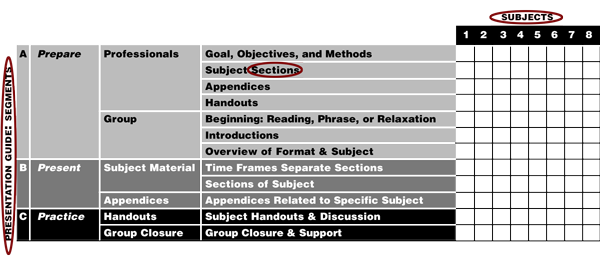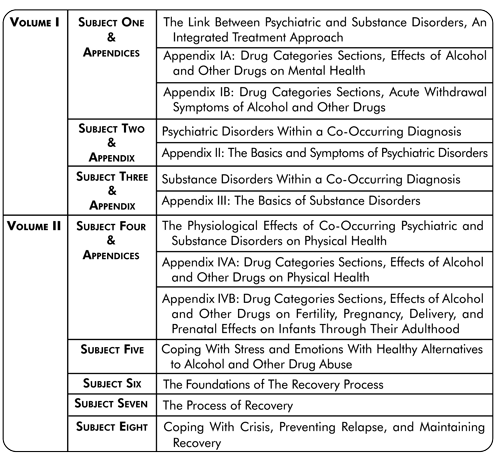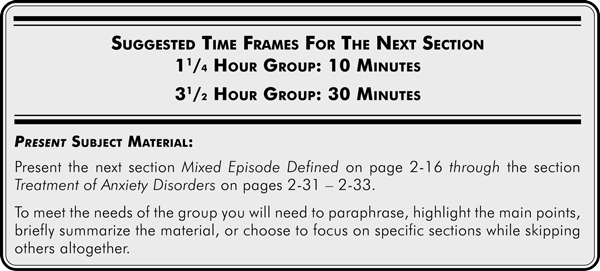ORGANIZATION: Subjects, Sections, Segments
Actually, the division of THE BASICS, Second Edition is somewhat difficult to explain in text. It’s probably much easier to make sense of it by actually looking at the curriculum while comparing it to these explanations.
Book Review Excerpt:
“With all this information at my fingertips it took me a while to settle down enough to understand how to put it all to good use. When I first picked up the curriculum and started browsing the pages, I found that I couldn’t stop. There is some great stuff in here, and I spent a considerable amount of time reviewing information but not gaining the rudiments of what, in a treatment setting, I might be doing with all of it. It was quite overwhelming! To my great relief, once I disciplined myself and started from the beginning it was clear that McKillip had engineered an approach that is well laid out. She clearly explains how to present the voluminous amount of data in a ‘Master Procedural Guide for Professionals,’ outlining several different approaches for doing so depending on the treatment setting and the time available.” Lindsay Freese (Professor of Human Service at New Hampshire Technical Institute; Addiction Professional Magazine: What’s Working in Treatment and Prevention, May 2005, A Co-Occurring Curriculum That’s Worth Its Weight)
Organization Challenge
A curriculum that could be used throughout the mental health and the chemical dependency treatment settings posed a great organizational challenge.
From Rhonda McKillip: When I became a Licensed Chemical Dependency Professional at a chemical dependency treatment agency, I struggled to find psychoeducational content for treatment participants.
The individuals in treatment were so interested and continually stated how much they benefited from learning about nutrition, stress, and other topics. They felt empowered. I couldn’t keep up with their questions and would find the answers to present in the next group. Their need and response encouraged me to learn more.
I also began to realize how much I needed to learn about integrated treatment since at least one-third of the individuals would have benefited from me having information on what symptoms a participant could recognize as a potential need to learn more about the sadness related to chemical dependency and the possibility of having a diagnosable depressive disorder. Sincerely Rhonda
The question: How do you organize a project where the range is so incredibly wide? On one hand, acute psychiatric units may have 8 single groups in 4 days. Long-term residential psychiatric facilities or chemical dependency agencies may offer as many as 80 groups or more over a two year time-frame. That means the range of curriculum needs to be helpful from groups or treatment where the range is four days to two years! Or from eight groups to eighty groups!
Solution = Divide THE BASICS into Subjects, Sections, and Segments
THE BASICS, Second Edition is initially separated into two volumes of Volume I and Volume II. Further division includes:
- First, the curriculum is divided into Eight Subjects.
- Second, each subject is divided into Four Sections of approximately 20 pages each.
- Third, each subject is designed around Presentation Segments of Prepare, Present, and Practice

Master Procedural Guide
The organizational guide of THE BASICS, Second Edition which is shown below is located in the beginning of Volume I in the Master Procedural Guide for Professionals. It is also found in the first page of every subject – after the subject table of contents – in the Presentation Guide for Professionals for example Subject Guide 1-I for Subject One.
The Subjects, Sections, and Segments are outlined at the beginning of each subject in the presentation guide as follows (G. Dunbar, personal communication, August 30, 2002):

Subjects
The two Volumes are divided into Eight Subjects. Volume I discusses Subject One through Subject Three and Volume II discusses Subject Four through Subject Eight. There are also six appendices throughout the two volumes. The Subjects are approximately 80 pages each. The following graphic shows the divisions:

Sections
Each one of the eight subjects is further divided into four sections. This meets the express dual goals of (1) allowing the material to be easily presented, and (2) making it easy to divide the content into several groups to meet your curriculum needs. As mentioned the subjects are approximately 80 pages each and the sections are approximately 20 pages each. Subject One and Subject Four have two appendices each and those are included in the approximate 80 pages.
The division into sections allows for flexibility in presentation. You can meet the needs of the group by:
- Paraphrasing subject material, and
- Highlighting the main points, and
- Briefly summarizing the material, or
- Choosing to focus on specific sections while skipping others altogether.
This allows the facilitator to present the material throughout a number of group sessions or present in its entirety in a single group session.
Suggested Time-Frames
The sections are divided by suggested time frames. The “suggested time frames” are for a 1¼ hour group or a 3½ hour group. They can provide you with some guidelines to help manage group time. Of course, coverage of subject material is always flexible. The time frames are simply that – suggestions and an example from Subject Two is shown in the graphic below:

The actual time will vary from the suggested time depending on the needs of the group and the group discussion time spent on particular key points of a subject. Always keep in mind, the most important aspect of any group is the interaction generated between group participants, especially during the handout discussion. The group should never feel like your need to cover the material is your most important goal. Covering the psychoeducation content is, of course, extremely important. Yet interacting about the topic is the most important goal. It what allows the individual to make use of the education and apply it to their own recovery plan.
That’s one of the reasons to prepare beforehand, in case you need to skip forward in order to highlight key points in a particular subject that you feel is especially important to cover in this particular group session. In other words, if the group’s desire to productively discuss a specific point or subject goes twice as long as you thought it might – then jump ahead to your key points.
You would still, of course, end the material presentation with the majority of the time in the group devoted to discussing the psychoeducational material and how it relates to each person individually. For example, the recommended time for working on the handout and discussion is 25 minutes for a 1¼ hour group and 60 minutes for a 3½ hour group. The recommended time for the positive group closure for either group is ten minutes.
Presenting the Curriculum In Its Entirety
One of the main headers on this website rhondamckillipandthebasics.com is Program Development. In the dropdown you will then see Curriculum Division Examples Into Specific Groups. If you want to explore a curriculum division that is divided into topics from the beginning of THE BASICS to the end you will find that under the title of Psychoeducational Content Subject One Through Subject Eight.
Segments
Each of the eight subjects – made up of four sections – is designed with three segments that make up the Presentation Style. The segments of each group are:
- Prepare (prepare professionals, prepare the group),
- Present (present curriculum topic(s) of the group), and
- Practice (discussions, exercises, worksheets).

The Segments of the Presentation Style: Prepare, Present, Practice is covered in more detail under the main menu heading of Lesson Plans
Or click here to go to Lesson Plans